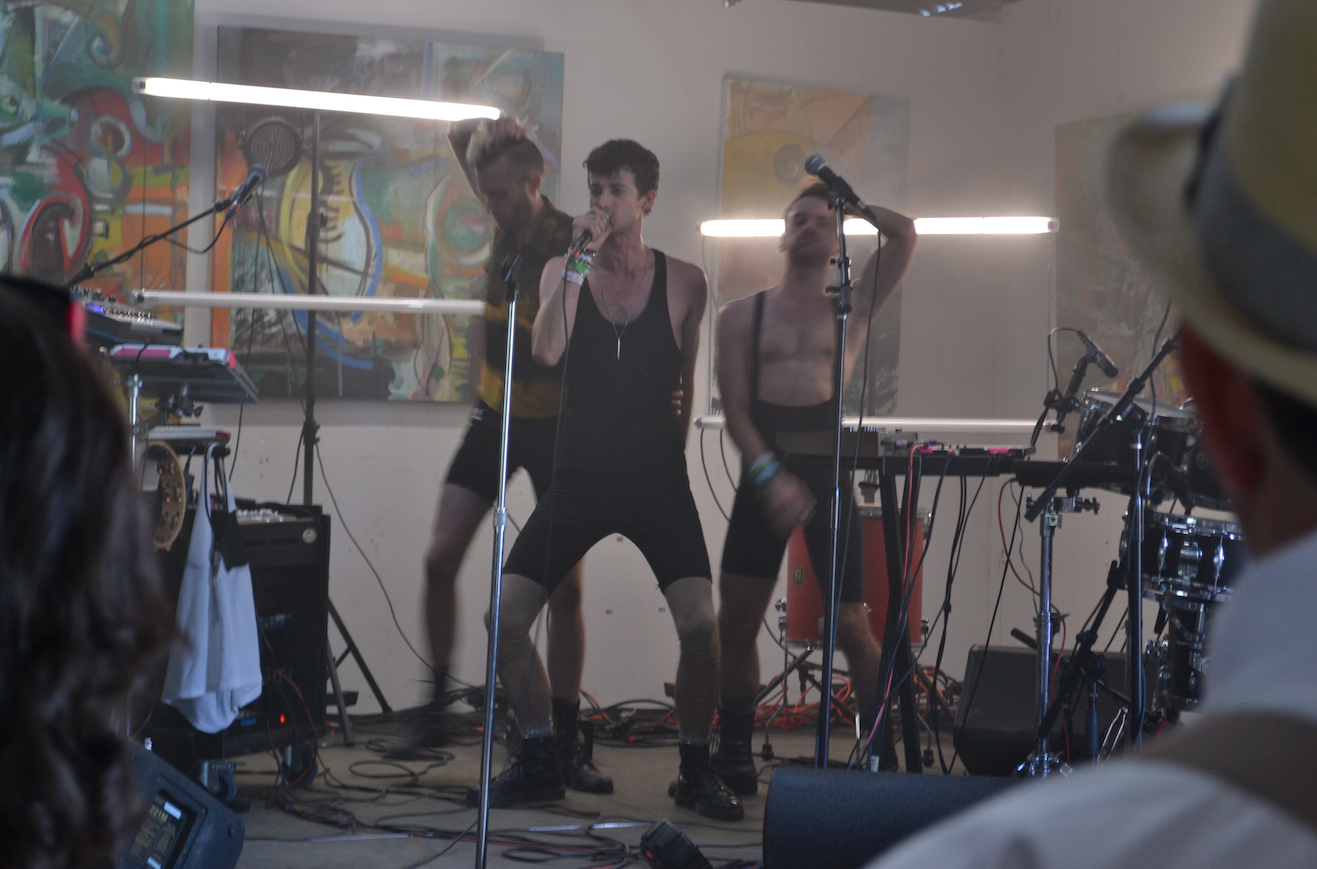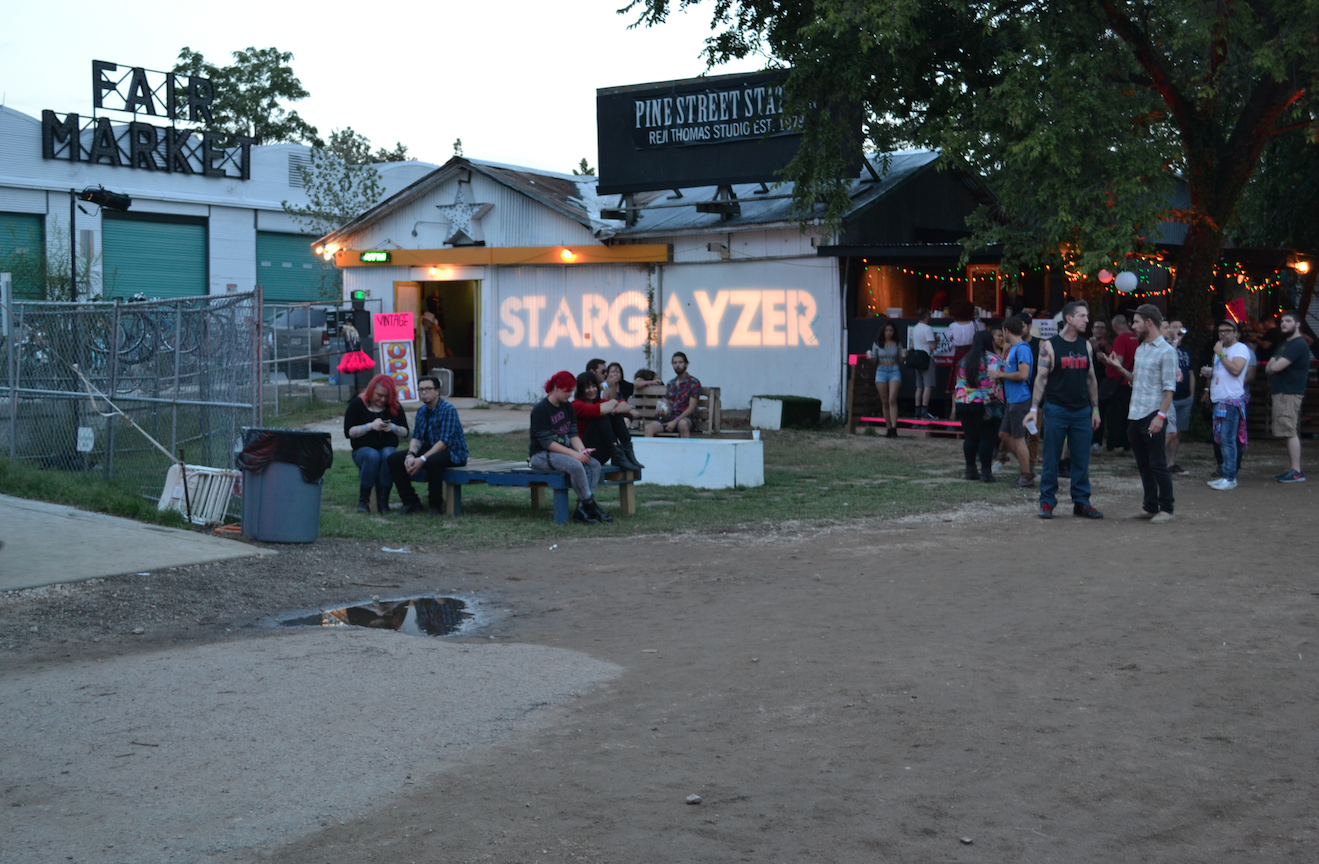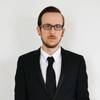They call the range of sexuality a spectrum because it is one. On the grounds of Stargayzer, Austin's first-year LGBTQIA music festival, is that beautiful multitude on display; one sees people of every size, shape, race, and orientation, bedecked in ink, sequins, elaborate eye makeup, gold chains, highlighter streaks across faces. Drag queens with baroque hairstyles and intricate outfits, cathedrals atop towering heels, move like parade floats, constantly surrounded, their presence enough to draw in satellites.Although the unseasonal rain and cold keeps the crowd modest, Stargayzer's lineup is top notch; among the myriad of LGBTQIA acts are headliners Austra, Xiu Xiu, Trust, Mykki Blanco, Big Freedia, Cakes Da Killa, Ssion, Kingdom, and Cazwell.BAATHHAUS goes on at six on the festival's third and final day, an unfortunate time slot because, even on the inside stage at the end of the imagineered shanty town midway that comprises the grounds, the sun is still high. The set goes on, the music and choreography and crowd reaction far and away the strongest on tour, but something is certainly lost in the iteration; BAATHHAUS is a dark band as DXM is a dark drug, and without the blackness and lights, it can not fairly be called a proper experience; this is not disappointing, so much as sympathy inducing.The BAATHHAUS aesthetic—light, sound, choreography—is cold, electric sex, something like Nine Inch Nails with a pop sensibility or New Order with the locus of longing residing in the loins instead of the heart, and feels like an esoteric 70's horror film in its combination of drama, astriction, and arousal. It cries out for blackness and roiling, sweating masses, the heavy industrial tones and 808 bass turning hot Cimmerian spaces into beating hearts.A key aspect to all of this comes from the stage show. Three-quarters of the group come from a theater-heavy background; critical notes and movements are highlighted by blasts of strobe and a shifting color palette heavy on blues, purples, greens and reds. The tight dance choreography—such an anomaly in bands which are not boy bands—leads to cheers whenever it debuts; the audience seems thrilled at the unexpected showmanship, perhaps connecting with the very overt manifestation of the lasciviousness which seems to inevitably follow the music.In any event, even beneath an inopportune Texan sun, BAATHHAUS sing and play, drum and dance and sweat and smile and leer, and after the strobe-pocked bridge and climax to "Cave Song" closes the show, they glisten with exertion and the soupcon of summer nights, a climactic ending to their first tour outside of their hometown of Chicago. The groundwork for the band was laid when Dan Foley, tired of the theater world and recently arrived in Chicago, began experimenting with making music in his apartment. In a call back to his theater roots, Foley decided to create a kind of burlesque performance art piece to go with his compositions in lieu of live playing. The resulting project, DAAN—much more focused on performance than being a proper band—debuted at Chicago bar Hamburger Mary's, quickly gaining notoriety for their unique—and often very wet—performances, which were never the same twice. Jesse Morgan Young and Patrick Andrews were brought on to direct and choreograph, respectively.DAAN became a live band—with Foley, Morgan Young, and Andrews rotating on synths and vocals—with the addition of percussionist Jesse Hoz, who brought both the more band-oriented musical expertise and infrastructure to make the transition happen."None of them had ever been in a band," Hoz says. "So the ability to take something that was essentially kind of happening—although collaboratively—in Dan's bedroom … it's like, how do we turn what happens into Dan's bedroom into something we can perform out and actually play it?"
The groundwork for the band was laid when Dan Foley, tired of the theater world and recently arrived in Chicago, began experimenting with making music in his apartment. In a call back to his theater roots, Foley decided to create a kind of burlesque performance art piece to go with his compositions in lieu of live playing. The resulting project, DAAN—much more focused on performance than being a proper band—debuted at Chicago bar Hamburger Mary's, quickly gaining notoriety for their unique—and often very wet—performances, which were never the same twice. Jesse Morgan Young and Patrick Andrews were brought on to direct and choreograph, respectively.DAAN became a live band—with Foley, Morgan Young, and Andrews rotating on synths and vocals—with the addition of percussionist Jesse Hoz, who brought both the more band-oriented musical expertise and infrastructure to make the transition happen."None of them had ever been in a band," Hoz says. "So the ability to take something that was essentially kind of happening—although collaboratively—in Dan's bedroom … it's like, how do we turn what happens into Dan's bedroom into something we can perform out and actually play it?" With people falling on varying parts of the sexual identity spectrum booked to play an LGBTQIA music and performance festival, discussion of queer culture and sexual orientation in life and art becomes inevitable. While three members of BAATHHAUS identify as gay or queer—if they choose to identify at all—and the lyrical content of the songs explicitly makes mention of male-on-male romance, is it fair, or even justified, to call them a "queer band?"Ruminations on queer culture (a term hereafter being used as a catch-all for the artistic contributions of anyone falling into that acronym) can quickly become thorny, wrapped up as they are in personal identities and fraught with the usual emotional implications of sex and love. There is no doubt that such a culture exists, fostered as it was by the hostility those who do not identify as straight encounter from the general population, and tempered in gay neighborhoods. Various aspects of queer culture have become appropriated into the mainstream, including drag and voguing, and the entertainment industry and creative fields have a long history of non-straight participants operating under varying amounts of openness.Now, as it becomes increasingly clear that the hostility towards the LGBTQIA community is receding—albeit with a long way to go, longer still for transgender people—should the idea of a queer culture be abandoned?While there is something beautiful in the idea that the "queer" appellate would become outdated as sexual orientation becomes relegated to just one small aspect of a person's life, there is also something sad in the possible dissolution of a legitimate—and proudly influential—cultural movement, even if born of adversity.Perhaps the best route to take is the one suggested by Andrews: to take every expression as it is, and allow the artist to determine what, if any, label should be attached.For what it is worth, BAATHHAUS does not set out to make music that is patently queer any more than they set out to be overtly sexual."Whether it's conscious or not, three of the artists in the band are queer," Young says. "And there's certainly no way that that doesn't affect the way we create and our identity as a band. I can only speak for myself, of course, but I'm sort of longing for the day when that's not a question. When people are just past that question."Follow B. David Zarley on Twitter.
With people falling on varying parts of the sexual identity spectrum booked to play an LGBTQIA music and performance festival, discussion of queer culture and sexual orientation in life and art becomes inevitable. While three members of BAATHHAUS identify as gay or queer—if they choose to identify at all—and the lyrical content of the songs explicitly makes mention of male-on-male romance, is it fair, or even justified, to call them a "queer band?"Ruminations on queer culture (a term hereafter being used as a catch-all for the artistic contributions of anyone falling into that acronym) can quickly become thorny, wrapped up as they are in personal identities and fraught with the usual emotional implications of sex and love. There is no doubt that such a culture exists, fostered as it was by the hostility those who do not identify as straight encounter from the general population, and tempered in gay neighborhoods. Various aspects of queer culture have become appropriated into the mainstream, including drag and voguing, and the entertainment industry and creative fields have a long history of non-straight participants operating under varying amounts of openness.Now, as it becomes increasingly clear that the hostility towards the LGBTQIA community is receding—albeit with a long way to go, longer still for transgender people—should the idea of a queer culture be abandoned?While there is something beautiful in the idea that the "queer" appellate would become outdated as sexual orientation becomes relegated to just one small aspect of a person's life, there is also something sad in the possible dissolution of a legitimate—and proudly influential—cultural movement, even if born of adversity.Perhaps the best route to take is the one suggested by Andrews: to take every expression as it is, and allow the artist to determine what, if any, label should be attached.For what it is worth, BAATHHAUS does not set out to make music that is patently queer any more than they set out to be overtly sexual."Whether it's conscious or not, three of the artists in the band are queer," Young says. "And there's certainly no way that that doesn't affect the way we create and our identity as a band. I can only speak for myself, of course, but I'm sort of longing for the day when that's not a question. When people are just past that question."Follow B. David Zarley on Twitter.
Advertisement
Advertisement

Advertisement

